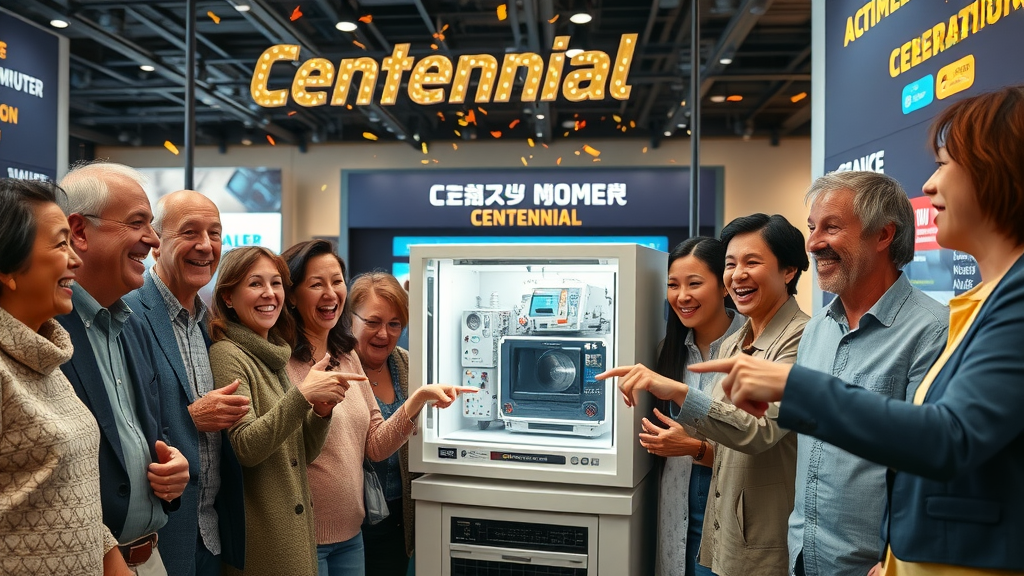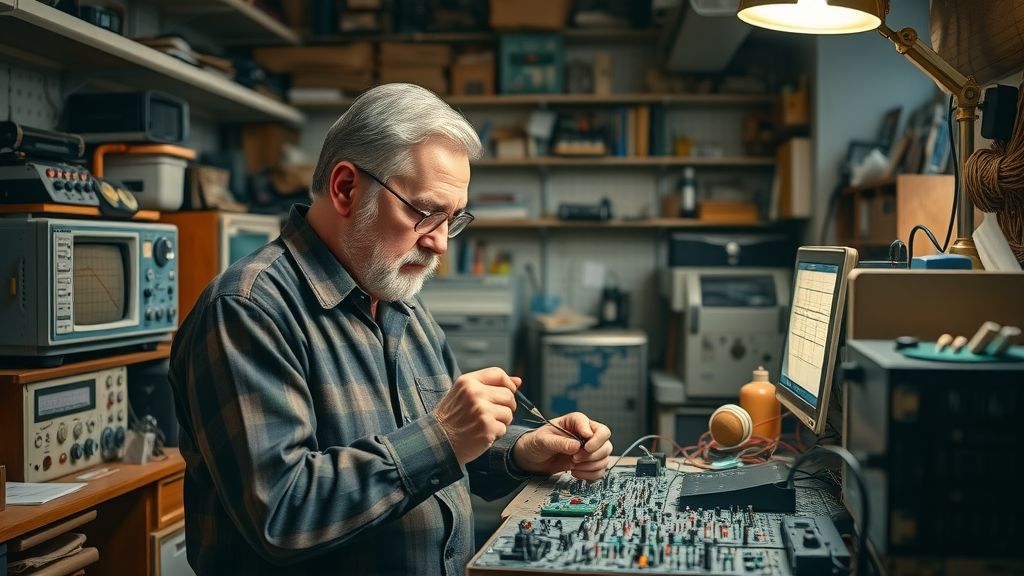Did you know? The rise of supercomputing cut calculation times from decades to mere hours, changing the course of science and industry forever. This centennial, remembering Seymour Cray on his 100th birthday isn’t just a nod to the past—it's a celebration of how one person, from rural Chippewa Falls, reshaped history. Dive in to explore the genius, legacy, and humanity behind the “Father of Supercomputing.”
A Startling Statistic: The Impact of Seymour Cray and Supercomputing
The vast technological growth we witness today owes much to Seymour Cray, whose visionary approach allowed computational problems that once took years to solve to be finished in mere hours. Cray’s pioneering supercomputers, including the legendary Cray-1 and its successors, dramatically accelerated fields like weather forecasting, nuclear research, and medicine. Today, industry and technology still stand on his innovations, with modern data centers and research labs tracing their roots to his designs. For example, the Cray-1, launched in 1976, was the fastest computer of its time and marked a seismic shift in what computers could achieve.
"Seymour Cray’s innovations shortened computational tasks from years to hours—redefining possibility."

- Pioneered the concept of vector processing, the backbone of modern supercomputing
- Founded Cray Research in Chippewa Falls, fostering local innovation
- Introduced innovative cooling systems—vital for high-speed computing
- Inspired generations of supercomputer engineers and global tech leaders
What You'll Learn in Remembering Seymour Cray on His 100th Birthday
- The legacy of Seymour Cray and his enduring influence
- How Cray’s inventions reshaped global technology norms
- Personal reflections and lesser-known stories about the man behind the machines
The Life and Genius of Seymour Cray
Early Years in Chippewa Falls

Seymour Cray’s story began in the picturesque small town of Chippewa Falls, Wisconsin. Growing up, he immersed himself in the region’s area history, its rivers and forests inspiring curiosity and inventiveness. According to local history center records, Cray, even as a child, built radios and sent morse code messages to his sister. Many credit this small-town upbringing with fostering his genius—a blend of ingenuity and hard work that left a permanent mark on the chippewa area history. As he grew, Cray’s fascination with electronics only intensified, culminating in his graduation from the local high school, where teachers recall him as relentless in his pursuit of knowledge. His connection to Chippewa Falls remained central throughout his remarkable journey, shaping his approach not just to machines, but to leadership and collaboration as well.
The chippewa falls museum of industry often shares tales of a young Cray scavenging surplus parts and creating home-built devices. This environment, surrounded by supportive community orgs technology events and influences, taught Cray the value of persistence, a trait that would lead him to become the supercomputer engineer who forever changed global computing.
Pioneering Days at Cray Research
- Notable milestones including the creation of the Cray-1 and Cray-2 supercomputers
- Cray’s unique and sometimes unconventional engineering methods—like working late at night for total focus
In 1972, Cray moved Cray Research to Chippewa Falls, making it the birthplace of unprecedented technological breakthroughs. Here, his team of people created the Cray-1—the fastest computer of its time, debuting in 1976. Its signature horseshoe design and liquid cooling system marked revolutionary advances, as highlighted in the area history center archives. Cray’s unique engineering approach—demanding precision, but allowing creative freedom—was pivotal in fostering innovation. Employees, as chronicled by museum of industry oral histories, remember working alongside a quietly intense man who valued results over process. By 1985, the Cray-2 raised the bar again with advanced cooling and processing power, cementing the company and its founder as industry and technology legends.
The influence of Cray Research didn’t end with new machines. The company became synonymous with a culture of collaboration, with the falls museum of industry noting that its achievements were an effort largely driven by shared commitment to pushing boundaries. As leader and mentor, Cray set expectations that inspired excellence, shaping not only hardware but also the next generation of supercomputer engineers around the world.
Personal Reflections: Why Remembering Seymour Cray on His 100th Birthday Matters
"To remember Seymour Cray is to celebrate a relentless pursuit of technological greatness."
Reflecting on remembering Seymour Cray on his 100th birthday reminds us not only of innovative machines, but of the relentless human drive to achieve the impossible. In a time when most thought of computers as room-sized calculators, Cray envisioned devices so advanced that they could simulate weather, unlock genetic secrets, and propel technological revolutions. The centennial is more than an event in honor of his birth—it’s a call to embrace intellectual curiosity and to challenge convention, just as Cray did in the Chippewa area history center’s famed “blue room.”
Personal anecdotes—many preserved by the falls museum of industry—reveal a humble genius who quietly reimagined what technology could do. Remembering Seymour Cray is about celebrating potential, innovation, and the power of one individual’s vision to shape the world for generations to come.
Influence on Modern Computing and the Tech Industry

Seymour Cray’s influence cannot be overstated; every supercomputer engineer and global technology leader recognizes his contributions. Today’s fastest computers, whether in climate modeling or molecular research, owe their lineage to his work. Major industry and technology advances—like cloud computing, artificial intelligence, and data-driven science—trace their DNA to ideas born in Chippewa Falls. As coordinator Alexis from the chippewa area history center notes, “Cray’s legacy is in every data center where innovation thrives.”
Years after his passing, Cray’s ethos guides community orgs technology events, inspiring new generations in places like the volume one produces annual technology expo at the falls museum of industry. His vision and philosophy—solving challenges through bold thinking—continue to steer supercomputer engineering, ensuring Cray’s century-old dream endures and evolves.
Celebrating Seymour Cray’s 100th Birthday: Honoring a Visionary
How Do You Honor a 100th Birthday?

Marking the hundredth birthday of a legend like Seymour Cray calls for more than cake and candles. Across Chippewa Falls and beyond, celebrations take place in the diamond-bright halls of museums and universities, with exhibitions featuring iconic artifacts like the Cray-1 horseshoe module. The chippewa falls museum of industry and local history center host commemorative events, inviting the community and the world to reflect on Cray’s journey from graduating high school in a small town to shaping the fastest computers earth has ever seen.
These centennial tributes include interactive displays, expert talks, and hands-on coding workshops—helping both young learners and seasoned engineers appreciate Cray’s impact. The event in honor of this supercomputer engineer highlights his blend of innovation and humility, revealing how one person from the chippewa area history center could spark a revolution in global computing. As people worldwide expect to view virtual tours and join livestreams, Cray’s birthday becomes a bridge uniting history, innovation, and aspiration.
Fascinating Facts About Seymour Cray
What are some interesting facts about Seymour Cray?
- Started Cray Research in Chippewa Falls, preserving his small-town connection
- The Cray-1 supercomputer’s iconic horseshoe shape solved wiring challenges and boosted performance
- Cray was famously private, known for gardening and skiing when not perfecting circuit designs
- Preferred to work during the night for maximum focus, setting a unique standard at Cray Research
- His legendary work habits are still cited in team of people management seminars and leadership workshops

Long before the fastest computers graced headlines, Cray experimented with unique solutions, inspired by both necessity and creativity. While some biographies highlight technical triumphs, lesser-known stories often focus on his quiet, determined approach. According to falls museum of industry archives, community orgs technology events would frequently invite Cray to speak, though he preferred solving engineering puzzles behind the scenes. From using morse code to communicate as a child to rigorously refining the cray research facility, his resourcefulness and discipline have inspired countless supercomputer engineers.
Even the museum of industry’s collection includes personal items, such as notebooks annotated with cryptic circuit diagrams, underlining Cray’s constant pursuit of perfection. He was the kind of mentor who led by example—expecting dedication, precision, and an unyielding drive to improve. Such anecdotes keep Cray’s legacy alive in both the chippewa falls museum community and global engineering circles.
Legacy in Chippewa Falls and Cray Research
Enduring Innovation from Chippewa Falls
The connection between Seymour Cray and Chippewa Falls is more than just geography; it’s about the enduring innovation that the chippewa area continues to nurture. Even today, the falls is brought up in engineering conferences as a site where vision and grit met to spark revolutions. Cray’s decision to keep his company and its most advanced laboratories in this Wisconsin town pulled attention—and talent—from around the world, enriching both the chippewa area history center and the global technology community.
Local institutions, like the falls museum of industry, play a pivotal role in preserving Cray’s story, offering visitors and students tangible connections to world-changing achievements. The annual technology events showcase how the chippewa falls is brought to the forefront each year in national engineering and computing conversations.
Cray Research: Pushing the Boundaries of Technology
Under Seymour Cray’s guidance, Cray Research was synonymous with crossing frontiers. The company’s hallmark was relentless experimentation. The table below highlights the milestones that defined a generation of progress—each achievement echoing Cray’s influence at the helm.
Each project that passed through Cray Research wasn’t just about building the fastest computers; it was about fundamentally re-imagining how data, science, and discovery could be advanced. The area history center records these milestones as hallmarks of both teamwork and bold solo innovation, making the fall of supercomputing a story for the ages.
| Milestone | Year | Significance |
|---|---|---|
| Cray-1 Launch | 1976 | Fastest computer of its time |
| Move to Chippewa Falls | 1972 | Home of Cray’s major inventions |
| Cray-2 Release | 1985 | Advanced cooling for supercomputing |
Seymour Cray: Reflections on a Trailblazer
"The world needs more visionaries like Seymour Cray—his curiosity knew no limits."
Why Cray’s Story Still Inspires Today

Remembering Seymour Cray on his 100th birthday isn’t just looking backward—it’s a call to action for the future. His blend of curiosity and discipline set standards that the industry and technology worlds still strive for today. Whether through formal tributes at the falls museum of industry or casual stories at the chippewa falls area history center, Cray’s philosophy—believe that no challenge is insurmountable—remains a unifying force for progress.
As technology accelerates toward new frontiers, the lessons of Seymour Cray’s life—embracing innovation, learning from failure, and never resting on past successes—ring truer than ever. Engineers and leaders worldwide are still inspired by his example to aim higher, work smarter, and imagine the next leap forward. The centennial celebration stands as proof that true vision endures, shaping not just machines, but the very way we understand and build our future.
Key Takeaways: Remembering Seymour Cray on His 100th Birthday
- Seymour Cray revolutionized computing with invention and ingenuity.
- His roots in Chippewa Falls played a key role in his lifelong success.
- The legacy of Cray Research endures in every facet of today’s supercomputing world.
Frequently Asked Questions: Remembering Seymour Cray on His 100th Birthday
What was Seymour Cray known for in supercomputing?
Seymour Cray is best known as the "father of supercomputing." His pioneering work at Cray Research produced the Cray-1 and Cray-2—the fastest computers of their era. These systems enabled breakthroughs in science, defense, and commercial computing, setting foundational standards for performance and design. Cray’s machines brought the world’s toughest challenges—like weather modeling and particle physics—within reach.
How did Cray's upbringing in Chippewa Falls influence his career?
The small town of Chippewa Falls profoundly shaped Seymour Cray’s character and drive. The supportive community, combined with ample space for experimentation, encouraged his fascination with electronics and engineering. Early experiences tinkering with radios and communicating via morse code laid the groundwork for the inventive mindset that led to global supercomputing achievements. This upbringing imbued Cray with both humility and the relentless curiosity that defined his entire career.
Conclusion: The Legacy Lives On—Why Remembering Seymour Cray on His 100th Birthday Remains Essential
- Cray’s vision set the groundwork for today’s data-driven world.
- Celebrating his 100th birthday recommits us to innovation and progress.
Connect with Us to Share Your Memories of Seymour Cray
Do you have a story about Seymour Cray or Chippewa Falls’ vibrant technology community? Call Us At (715) 944-6710 Or Email Us info@contentspark360.com—we’d love to help preserve and amplify these remarkable memories.
 Add Row
Add Row  Add
Add 




Write A Comment